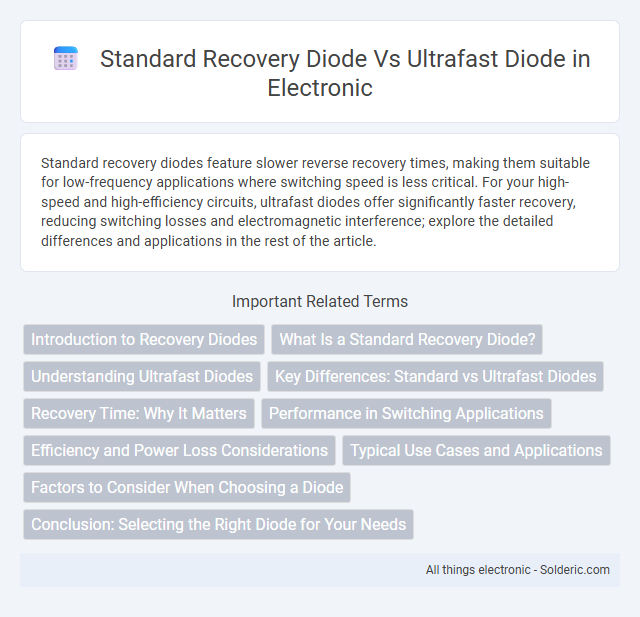Standard recovery diodes feature slower reverse recovery times, making them suitable for low-frequency applications where switching speed is less critical. For your high-speed and high-efficiency circuits, ultrafast diodes offer significantly faster recovery, reducing switching losses and electromagnetic interference; explore the detailed differences and applications in the rest of the article.
Comparison Table
| Feature | Standard Recovery Diode | Ultrafast Recovery Diode |
|---|---|---|
| Recovery Time | 1 to 5 microseconds | 10 to 50 nanoseconds |
| Switching Speed | Slow | Very fast |
| Reverse Recovery Charge | High | Low |
| Applications | Low-frequency rectification, general purpose | High-frequency switching, power converters, SMPS |
| Power Loss | Higher due to slower switching | Lower, improved efficiency |
| Cost | Lower | Higher |
Introduction to Recovery Diodes
Standard recovery diodes feature a relatively slow reverse recovery time, making them suitable for applications with low switching frequencies and minimal electromagnetic interference concerns. Ultrafast diodes, characterized by their significantly reduced reverse recovery time, improve efficiency and reduce switching losses in high-frequency circuits such as switched-mode power supplies and motor drives. Optimizing diode selection based on recovery time enhances overall circuit performance and thermal management in power electronics.
What Is a Standard Recovery Diode?
A standard recovery diode is a semiconductor device designed to allow current to flow in one direction while blocking it in the reverse, featuring a slower reverse recovery time compared to ultrafast diodes. This diode type is commonly used in applications where switching speed is less critical, such as in rectifiers for power supplies and general-purpose circuits. Understanding the characteristics of a standard recovery diode can help you select the right component for your circuit's performance and efficiency requirements.
Understanding Ultrafast Diodes
Ultrafast diodes feature recovery times typically in the range of a few nanoseconds, enabling efficient switching in high-frequency applications, unlike standard recovery diodes which have slower recovery times often exceeding microseconds. The reduced reverse recovery time minimizes switching losses and electromagnetic interference in circuits such as switch-mode power supplies and high-speed rectifiers. These characteristics make ultrafast diodes essential for enhancing performance and reliability in modern electronic devices requiring rapid response and low energy dissipation.
Key Differences: Standard vs Ultrafast Diodes
Standard recovery diodes feature slower reverse recovery times, typically in the microsecond range, making them suitable for low-frequency applications with minimal switching losses. Ultrafast diodes boast recovery times in the nanosecond range, significantly reducing switching losses and electromagnetic interference in high-speed circuits. Choosing between these diodes impacts your system's efficiency and performance, especially in power electronics and high-frequency switching environments.
Recovery Time: Why It Matters
Standard recovery diodes typically have longer recovery times, often in the range of microseconds, which can lead to increased switching losses and reduced efficiency in high-frequency applications. Ultrafast diodes feature recovery times in the order of nanoseconds, minimizing reverse recovery charge and enabling faster switching speeds critical for power electronics and RF circuits. Faster recovery time reduces electromagnetic interference (EMI) and thermal stress, enhancing overall device performance and reliability.
Performance in Switching Applications
Ultrafast diodes exhibit significantly faster reverse recovery times compared to standard recovery diodes, making them ideal for high-frequency switching applications and reducing switching losses. Standard recovery diodes typically have longer recovery times, leading to higher energy dissipation and reduced efficiency in circuits operating at high speeds. The superior performance of ultrafast diodes in minimizing switching noise and enhancing overall circuit efficiency is critical in power electronics and RF applications.
Efficiency and Power Loss Considerations
Standard recovery diodes exhibit longer reverse recovery times, leading to higher switching losses and reduced efficiency in high-frequency applications. Ultrafast diodes have significantly shorter reverse recovery times, minimizing power loss and improving overall system efficiency, especially in power conversion and switching circuits. Selecting ultrafast diodes enhances performance by reducing heat generation and increasing energy efficiency in demanding electronic designs.
Typical Use Cases and Applications
Standard recovery diodes are commonly used in power rectification tasks such as AC to DC conversion in power supplies, where switching speeds are moderate, and cost-efficiency is prioritized. Ultrafast diodes find applications in high-frequency switching circuits like switch-mode power supplies, voltage clamping, and fast switching power electronics due to their low reverse recovery time and minimal switching losses. Typical industries using ultrafast diodes include telecommunications, automotive electronics, and renewable energy systems requiring rapid response times and energy-efficient performance.
Factors to Consider When Choosing a Diode
Standard recovery diodes offer reliable performance for general rectification tasks due to their moderate switching speeds and lower cost, making them suitable for applications where efficiency is less critical. Ultrafast diodes provide significantly reduced reverse recovery times and lower switching losses, essential for high-frequency circuits and power electronics to enhance overall efficiency and reduce electromagnetic interference. When choosing a diode, consider your circuit's switching speed, power dissipation requirements, and cost constraints to ensure optimal performance and durability.
Conclusion: Selecting the Right Diode for Your Needs
Standard recovery diodes offer reliable performance for general switching and rectification tasks but exhibit slower reverse recovery times, limiting their efficiency in high-speed applications. Ultrafast diodes, with significantly reduced recovery times, enhance performance in switching power supplies and high-frequency circuits by minimizing switching losses and electromagnetic interference. Your choice depends on balancing cost and speed requirements, where ultrafast diodes are ideal for demanding, high-frequency environments while standard recovery diodes suit less time-sensitive applications.
Standard recovery diode vs ultrafast diode Infographic

 solderic.com
solderic.com